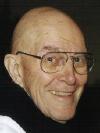Issue Date: December 14, 2007
 |
| Fr. Thomas Keating |
Keating moved the movement
By THOMAS C. FOX
Benedictine Fr. Thomas Keating, one of the architects of the
contemplative prayer movement, entered the Cistercian Order in 1944. He was
appointed superior of St. Benedict’s Monastery in Snowmass, Colo., in
1958. He was elected abbot of St. Joseph’s Abbey, Spencer, Mass., in 1961.
After retiring as abbot of Spencer in 1981, Keating returned to Snowmass, where
he lives at St. Benedict’s Monastery.
NCR: What is the purpose of contemplative
prayer?
Keating: Contemplative prayer is not just a method of prayer;
it’s a way of life. And it’s not just a way of life, it’s a way
of transformed life, that is, a way of becoming God, of participating more
fully in divine nature. If prayer is abstract and not experienced, if it’s
not waited for, not loved, not practiced, we really don’t know what it
is.
What are the origins of centering prayer?
Centering prayer is
not new. It’s simply an effort to update the contemplative tradition
coming down from the Church Fathers and Mothers and later the Carmelites like
John of the Cross, Teresa of Avila and others. It goes far back in our church
history but got lost after the Middle Ages.
How did contemplative prayer begin in modern times?
It was in
the early 1970s that [Trappist] Fr. William Meninger put together the first
guidelines for contemplative meditation. He followed completely the book The
Cloud of Unknowing. He taught it to priests who came regularly to our
monastery for their annual retreats. He has a brilliant grasp of The
Cloud and is an outstanding lecturer. It’s the same idea that
[Benedictine Fr.] John Main seems to have had about the same time when he first
came to Montreal with his assistant, [Benedictine Fr.] Laurence Freeman.
What lessons have you learned from contemplative
prayer?
I’ve learned contemplative prayer corresponds remarkably
with the perennial philosophy and the stages of consciousness that you find in
Buddhism, and especially in some of the Hindu traditions as well as among the
Sufis and in Jewish mysticism. There are remarkable similarities in content and
method among the different traditions. This prompted me when I retired and went
to Snowmass to start an interreligious dialogue that actually became a kind of
interspiritual dialogue.
How can one learn more about those dialogue
experiences?
There’s a little book that describes how we approached
this spiritual dialogue. It’s called The Common Heart: An Experience of
Interreligious Dialogue. It explains what we came up with in agreement and
all the things we do in common that are practical, like sacred reading,
fasting, bringing the fruits of meditation to daily life and having a spiritual
guide. All this is the human way of engaging the whole person in the
transformative project, which to me at this point in my life -- I’m almost
85 -- is what this universe is all about.
How was centering prayer first received?
These priests we had
taught, a significant percentage of them, maybe a third of them, began to
spread the word themselves. This isn’t something people pick up right away
except if they have already had some background in cultivating interior silence
because interior silence is kind of countercultural at the present time. Some
people have never even experienced a moment of silence and have no idea what
their deep self is like.
Why the early reluctance by some to accept contemplative
prayer?
Some people were afraid to talk about it or thought it esoteric
or thought it was just pride to talk about contemplation unless you were in a
monastery and even there it wasn’t taught very much using that word. Our
teaching is that contemplative prayer is a gift that has been given, that with
a little reduction of the obstacles produced by the false self, you can awaken
an essential and integral part of human nature. It depends on consenting,
however; on consenting to the power of grace and consenting to the Gospel
invitation to transformation and, as the early Fathers and Mothers called it,
unabashedly, to be deified. In other words, we are not talking here about
becoming a saint or an enlightened person. Jesus’ invitation is to become
“no thing,” that is to be totally disposed of any possessive attitude
because the Trinity is nothing but love.
The goal is to deepen one’s relationship with God. That’s the
foundation of the spiritual journey based on belief in the divine indwelling,
the life of the Trinity within. This view dramatically shifts the way one looks
at prayer and the sacraments. Prayer and the sacraments are to help us manifest
the true self, to manifest a transformed self.
Why silence?
It’s the practice of furthering interior
silence that makes all the difference. Silence is so much an aspect of the
spirituality of both the Old and New Testament. Everything comes out of silence
and returns to it. It is in the practice of silence that you begin to become
vulnerable. It’s in silence one develops, in the words of St. John of the
Cross, the continuous consciousness of God.
Is centering prayer meant for everyone?
We all need a balance
between silence and action, between prayer and service. Centering prayer is
especially for people working in various ministries who need this balance. As a
method, centering prayer is only an introduction to the classical contemplative
Christian traditions. It is my belief that people who have practiced the
Christian religion for some years don’t need a lot of discursive
meditation. They need contemplation. The problem with thinking is, even in a
devout way, we get attached to what we think and get stuck. The brain is very
clever and tries to protect itself from change. Contemplative prayer can break
us out of these grips. In contemplative prayer we really can hear the word of
God.
National Catholic Reporter, December 14,
2007 |

